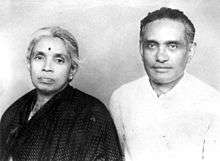Gundugutti Manjanathaya
| Gundugutti M. Manjanathaya | |
|---|---|
| Born |
G. M. Manjanatha Kodagu (Coorg), India |
| Nationality | Indian |
| Occupation | Freedom Fighter, Politician |
| Signature | |
 | |

Gundugutti M. Manjanathaya[1] was an Indian freedom fighter and politician. Born as G. M. Manjanath, he was a prominent coffee planter and lived in the village of Gundugutti in Somwarpet taluk in Kodagu district.[2]
Freedom Movement
In 1934, Pandyanda Belliappa, another prominent freedom fighter, and Gundugutti Manjanathaya succeeded in persuading Mahatma Gandhi to tour Coorg for his cause of gaining donations towards the Harijan welfare fund. They accompanied him into Coorg and he stayed at Gundugutti Manjanathaya's house for one evening. It was here that Mrs. B. T. Gopal Krishna, better known as Kodagina Gowramma, a famous Kannada woman writer and his relative, donated her jewellery for the cause and invited the entourage to her house.[3][4][5] During the 1942 Quit India Movement Manjanathaya's eldest son Gundugutti Narasimhamurthy organised a Seva Mandal in Madikeri to inspire the youth.[4]
Politics
In 1947 Coorg was a separate state in South India. Coorg had two MPs in the Union Parliament then, besides having a state legislative body. Manjanathaya was elected MLA (Member of the Legislative Assembly) of the State of Coorg (now Kodagu), between the years 1952-1957 and represented Sunticoppa I constituency as a member of the Indian National Congress party. In 1956 the State Reorganisation Act was passed. Coorg was merged with Mysore and the legislative body at Mercara dissolved. In 1967 G.M. Manjanathaya represented the Swatantra Party and defeated INC candidate C.K. Kalappa in Somwarpet in the Mysore State (Old name for Karnataka) Elections.[6][7][8][9]
References
- ↑ "Karnataka Assembly Election Results in 1967". www.elections.in. http://www.elections.in. Retrieved 7 August 2016. External link in
|publisher=(help) - ↑ Mysore Information, Volume 22, Issues 1-5. Mysore (India : State). Information Dept. 1958. pp. 22–24. Retrieved 6 August 2014.
- ↑ Gandhi's campaign against untouchability, 1933-34: an account from the Raj's secret official reports. New Delhi, India: Gandhi Peace Foundation. 1996. p. 111. Retrieved 6 August 2014.
- 1 2 Kamath, Dr. S. U. (1993). Karnataka State gazetteer, Kodagu. Director of Print, Stationery and Publications at the Government Press. pp. 101, 102. Retrieved 6 August 2014.
- ↑ Kushalappa, Mookonda (2014). Long ago in Coorg. pp. 352, 354.
- ↑ Chinnappa, K. Jeevan (29 April 2008). "From a princely State to two Assembly segments". The Hindu. Retrieved 6 August 2014.
- ↑ Appaiah, Ashwini. "Stress laid on religious tolerance at I-Day event in Kodagu". Team Mangalorean. Retrieved 6 August 2014.
- ↑ Karanth, Kota Shivarama (1 Jan 1993). Ten Faces of a Crazy Mind: Autobiography (translated from Kannada). Bharatiya Vidya Bhavan,. p. 285. Retrieved 6 August 2014.
- ↑ Aiythoughts. "Indian Freedom Struggle Memorial @ Gonikoppal". Aiythoughts. Aiythoughts. Retrieved 6 August 2014.